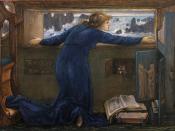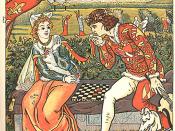The Franklin attempts to adopt the form of the traditional Breton Lay, telling a story of romance concerned with human relationships and social order. To some extent he succeeds, but in some aspects the Franklin, who I am sure has best interests at heart, fails miserably. The Franklin, in his prologue, tells the rest of the company that he 'lerned nevere rethorik'. He does not know how to use figures of speech and that the company must forgive him for his simple, bare and plain tale. This is all very well, but immediately he slips into rhetoric when describing Arveragus of Kayrrud telling his company of his chivalric exploits and hard won affections of his lady. The Franklin firstly describes lady Dorigen as 'the faireste under sonne' and in the next line undermines her beauty by saying 'eek therto comen of so heigh kynrede'. The Franklin knows what high rhetoric is.
Even if he didn't know before, he certainly knows after listening to the Knight's Tale. By telling us that lady Dorigen is more importantly a woman of noble birth with some wealth to her name, than a beautiful heavenly creature, the Franklin makes us doubt whether Arveragus actually wants her for her beauty or for her wealth. The whole tale is certainly a glimpse of how life and love would work out perfectly well if everyone is truthful, kept to their word and honored their fellows. But here in the first paragraph of the tale, we are led immediately to doubt whether everything is as peachy as it seems.
We need look no further than a few more lines to find exactly the same thing happening from Dorigen's perspective. The Franklin tells us that the lady submitted to him for his 'worthiness', but 'namely for his meke obeysaunce'.


